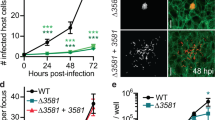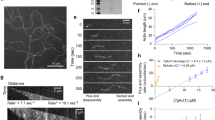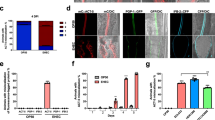Abstract
During infection, enterohaemorrhagic Escherichia coli (EHEC) takes over the actin cytoskeleton of eukaryotic cells by injecting the EspFU protein into the host cytoplasm1,2. EspFU controls actin by activating members of the Wiskott–Aldrich syndrome protein (WASP) family1,2,3,4,5. Here we show that EspFU binds to the autoinhibitory GTPase binding domain (GBD) in WASP proteins and displaces it from the activity-bearing VCA domain (for verprolin homology, central hydrophobic and acidic regions). This interaction potently activates WASP and neural (N)-WASP in vitro and induces localized actin assembly in cells. In the solution structure of the GBD–EspFU complex, EspFU forms an amphipathic helix that binds the GBD, mimicking interactions of the VCA domain in autoinhibited WASP. Thus, EspFU activates WASP by competing directly for the VCA binding site on the GBD. This mechanism is distinct from that used by the eukaryotic activators Cdc42 and SH2 domains, which globally destabilize the GBD fold to release the VCA6,7,8. Such diversity of mechanism in WASP proteins is distinct from other multimodular systems, and may result from the intrinsically unstructured nature of the isolated GBD and VCA elements. The structural incompatibility of the GBD complexes with EspFU and Cdc42/SH2, plus high-affinity EspFU binding, enable EHEC to hijack the eukaryotic cytoskeletal machinery effectively.
This is a preview of subscription content, access via your institution
Access options
Subscribe to this journal
Receive 51 print issues and online access
$199.00 per year
only $3.90 per issue
Buy this article
- Purchase on Springer Link
- Instant access to full article PDF
Prices may be subject to local taxes which are calculated during checkout



Similar content being viewed by others
References
Campellone, K. G., Robbins, D. & Leong, J. M. EspFU is a translocated EHEC effector that interacts with Tir and N-WASP and promotes Nck-independent actin assembly. Dev. Cell 7, 217–228 (2004)
Garmendia, J. et al. TccP is an enterohaemorrhagic Escherichia coli O157:H7 type III effector protein that couples Tir to the actin-cytoskeleton. Cell. Microbiol. 6, 1167–1183 (2004)
Campellone, K. G. et al. Enterohaemorrhagic Escherichia coli Tir requires a C-terminal 12-residue peptide to initiate EspFu-mediated actin assembly and harbours N-terminal sequences that influence pedestal length. Cell. Microbiol. 8, 1488–1503 (2006)
Garmendia, J., Carlier, M. F., Egile, C., Didry, D. & Frankel, G. Characterization of TccP-mediated N-WASP activation during enterohaemorrhagic Escherichia coli infection. Cell. Microbiol. 8, 1444–1455 (2006)
Lommel, S., Benesch, S., Rohde, M., Wehland, J. & Rottner, K. Enterohaemorrhagic and enteropathogenic Escherichia coli use different mechanisms for actin pedestal formation that converge on N-WASP. Cell. Microbiol. 6, 243–254 (2004)
Buck, M., Xu, W. & Rosen, M. K. A two-state allosteric model for autoinhibition rationalizes WASP signal integration and targeting. J. Mol. Biol. 338, 271–285 (2004)
Kim, A. S., Kakalis, L. T., Abdul-Manan, N., Liu, G. A. & Rosen, M. K. Autoinhibition and activation mechanisms of the Wiskott–Aldrich syndrome protein. Nature 404, 151–158 (2000)
Torres, E. & Rosen, M. K. Contingent phosphorylation/dephosphorylation provides a mechanism of molecular memory in WASP. Mol. Cell 11, 1215–1227 (2003)
Munter, S., Way, M. & Frischknecht, F. Signaling during pathogen infection. Sci. STKE 2006, re5 (2006)
Caron, E. et al. Subversion of actin dynamics by EPEC and EHEC. Curr. Opin. Microbiol. 9, 40–45 (2006)
Hayward, R. D., Leong, J. M., Koronakis, V. & Campellone, K. G. Exploiting pathogenic Escherichia coli to model transmembrane receptor signalling. Nature Rev. Microbiol. 4, 358–370 (2006)
Gruenheid, S. & Finlay, B. B. Microbial pathogenesis and cytoskeletal function. Nature 422, 775–781 (2003)
Galán, J. E. & Cossart, P. Host-pathogen interactions: a diversity of themes, a variety of molecular machines. Curr. Opin. Microbiol. 8, 1–3 (2005)
Rangel, J. M., Sparling, P. H., Crowe, C., Griffin, P. M. & Swerdlow, D. L. Epidemiology of Escherichia coli O157:H7 outbreaks, United States, 1982–2002. Emerg. Infect. Dis. 11, 603–609 (2005)
DeVinney, R. et al. Enterohemorrhagic Escherichia coli O157:H7 produces Tir, which is translocated to the host cell membrane but is not tyrosine phosphorylated. Infect. Immun. 67, 2389–2398 (1999)
Higgs, H. N. & Pollard, T. D. Regulation of actin filament network formation through Arp2/3 complex: Activation by a diverse array of proteins. Annu. Rev. Biochem. 70, 649–676 (2001)
Kelly, A. E., Kranitz, H., Dotsch, V. & Mullins, R. D. Actin binding to the central domain of WASP/Scar proteins plays a critical role in the activation of the Arp2/3 complex. J. Biol. Chem. 281, 10589–10597 (2006)
Panchal, S. C., Kaiser, D. A., Torres, E., Pollard, T. D. & Rosen, M. K. A conserved amphipathic helix in WASP/Scar proteins is essential for activation of Arp2/3 complex. Nature Struct. Biol. 10, 591–598 (2003)
Rohatgi, R. et al. The interaction between N-WASP and the Arp2/3 complex links Cdc42-dependent signals to actin assembly. Cell 97, 221–231 (1999)
Buck, M., Xu, W. & Rosen, M. K. Global disruption of the WASP autoinhibited structure on Cdc42 binding. Ligand displacement as a novel method for monitoring amide hydrogen exchange. Biochemistry 40, 14115–14122 (2001)
Leung, D. W. & Rosen, M. K. The nucleotide switch in Cdc42 modulates coupling between the GTPase-binding and allosteric equilibria of Wiskott–Aldrich syndrome protein. Proc. Natl Acad. Sci. USA 102, 5685–5690 (2005)
Garmendia, J. et al. Distribution of tccP in clinical enterohemorrhagic and enteropathogenic Escherichia coli isolates. J. Clin. Microbiol. 43, 5715–5720 (2005)
Alto, N. M. et al. The type III effector EspF coordinates membrane trafficking by the spatiotemporal activation of two eukaryotic signaling pathways. J. Cell Biol. 178, 1265–1278 (2007)
Volkman, B. F., Prehoda, K. E., Scott, J. A., Peterson, F. C. & Lim, W. A. Structure of the N-WASP EVH1 domain-WIP complex: insight into the molecular basis of Wiskott–Aldrich Syndrome. Cell 111, 565–576 (2002)
Higgs, H. N., Blanchoin, L. & Pollard, T. D. Influence of the C terminus of Wiskott-Aldrich syndrome protein (WASp) and the Arp2/3 complex on actin polymerization. Biochemistry 38, 15212–15222 (1999)
Cooper, J. A. & Pollard, T. D. Methods to measure actin polymerization. Methods Enzymol. 85, 182–210 (1982)
Leung, D. W., Morgan, D. M. & Rosen, M. K. Biochemical properties and inhibitors of (N-)WASP. Methods Enzymol. 406, 281–296 (2006)
Pace, C. N. Measuring and increasing protein stability. Trends Biotechnol. 8, 93–98 (1990)
Campellone, K. G., Giese, A., Tipper, D. J. & Leong, J. M. A tyrosine-phosphorylated 12-amino-acid sequence of enteropathogenic Escherichia coli Tir binds the host adaptor protein Nck and is required for Nck localization to actin pedestals. Mol. Microbiol. 43, 1227–1241 (2002)
Rieping, W. et al. ARIA2: automated NOE assignment and data integration in NMR structure calculation. Bioinformatics 23, 381–382 (2007)
Goto, N. K., Gardner, K. H., Mueller, G. A., Willis, R. C. & Kay, L. E. A robust and cost-effective method for the production of Val, Leu, Ile (δ1) methyl-protonated 15N-, 13C-, 2H-labeled proteins. J. Biomol. NMR 13, 369–374 (1999)
Gardner, K. H. & Kay, L. E. Production and incorporation of 15N, 13C, 2H (1H-δ1 methyl) isoleucine into proteins for multidimensional NMR studies. J. Am. Chem. Soc. 119, 7599–7600 (1997)
Clore, G. M. & Gronenborn, A. M. Multidimensional heteronuclear nuclear magnetic resonance of proteins. Methods Enzymol. 239, 349–363 (1994)
Muhandiram, D. R. & Kay, L. E. Gradient-enhanced triple-resonance three-dimensional NMR experiments with improved sensitivity. J. Magn. Reson. B 103, 203–216 (1994)
Clore, G. M., Kay, L. E., Bax, A. & Gronenborn, A. M. Four-dimensional 13C/13C-edited nuclear Overhauser enhancement spectroscopy of a protein in solution: application to interleukin 1β. Biochemistry 30, 12–18 (1991)
Zwahlen, C. et al. Methods for measurement of intermolecular NOEs by multinuclear NMR spectroscopy: application to a bacteriophage λ N-peptide/boxB RNA complex. J. Am. Chem. Soc. 119, 6711–6721 (1997)
Cornilescu, G., Delaglio, F. & Bax, A. Protein backbone angle restraints from searching a database for chemical shift and sequence homology. J. Biomol. NMR 13, 289–302 (1999)
Linge, J. P., Williams, M. A., Spronk, C. A., Bonvin, A. M. & Nilges, M. Refinement of protein structures in explicit solvent. Proteins 50, 496–506 (2003)
Delaglio, F. et al. NMRPipe: a multidimensional spectral processing system based on UNIX pipes. J. Biomol. NMR 6, 277–293 (1995)
Johnson, B. A. & Blevins, R. A. NMR View: A computer program for the visualization and analysis of NMR data. J. Biomol. NMR 4, 603–614 (1994)
Laskowski, R. A., Rullmannn, J. A., MacArthur, M. W., Kaptein, R. & Thornton, J. M. AQUA and PROCHECK-NMR: programs for checking the quality of protein structures solved by NMR. J. Biomol. NMR 8, 477–486 (1996)
Carson, M., Charles, W. C. & Robert, M. S. Methods in Enzymology 493–502 (Academic, 1997)
DeLano, W. L. The PyMOL User’s Manual (DeLano Scientific, 2002)
Acknowledgements
We thank T. Otomo for discussion and assistance on biochemical assays and NMR spectroscopy; P. Li, I. Martins, C. A. Amezcua, K. H. Gardner and Q. Wu for assistance with NMR spectroscopy and structure calculations; G. K. Amarasinghe and D. W. Leung for sharing reagents; D. Trobaugh, J. Rennie and D. Robbins for technical assistance; S. B. Padrick for help with Mathematica and X. Yao and S. B. Padrick for assistance in writing and for critical reading of the manuscript. This work was supported by grants from the National Institute of Health (NIH-R01-GM56322 to M.K.R.; NIH-R01-AI46454 to J.M.L.), Welch Foundation (I–1544 to M.K.R.) and a Chilton Foundation Fellowship to H.-C.C.
Author information
Authors and Affiliations
Corresponding author
Supplementary information
Supplementary Information 1
This file contains Supplementary Table S1 and Supplementary Figures S1- S13 with Legends. (PDF 12456 kb)
Rights and permissions
About this article
Cite this article
Cheng, HC., Skehan, B., Campellone, K. et al. Structural mechanism of WASP activation by the enterohaemorrhagic E. coli effector EspFU. Nature 454, 1009–1013 (2008). https://doi.org/10.1038/nature07160
Received:
Accepted:
Published:
Issue Date:
DOI: https://doi.org/10.1038/nature07160
This article is cited by
-
A single chlamydial protein reshapes the plasma membrane and serves as recruiting platform for central endocytic effector proteins
Communications Biology (2023)
-
A glycine-rich PE_PGRS protein governs mycobacterial actin-based motility
Nature Communications (2022)
-
1H, 13C, and 15N NMR chemical shift assignment of the complex formed by the first EPEC EspF repeat and N-WASP GTPase binding domain
Biomolecular NMR Assignments (2021)
-
Mechanism of actin filament nucleation by the bacterial effector VopL
Nature Structural & Molecular Biology (2011)
-
Molecular mechanisms of Escherichia coli pathogenicity
Nature Reviews Microbiology (2010)
Comments
By submitting a comment you agree to abide by our Terms and Community Guidelines. If you find something abusive or that does not comply with our terms or guidelines please flag it as inappropriate.



